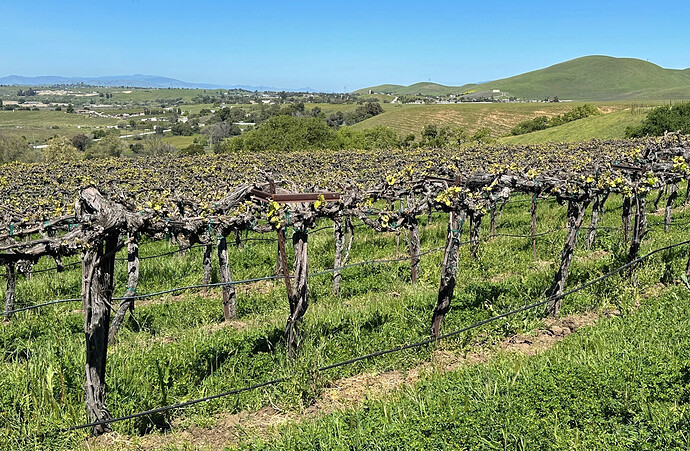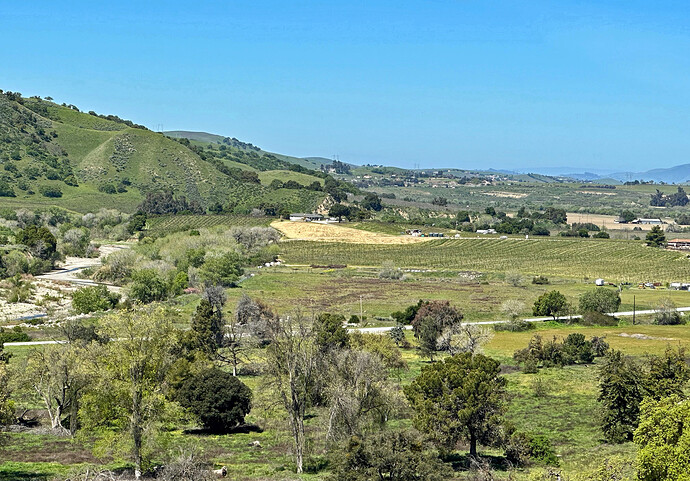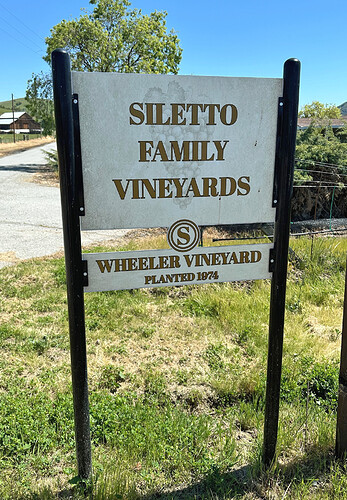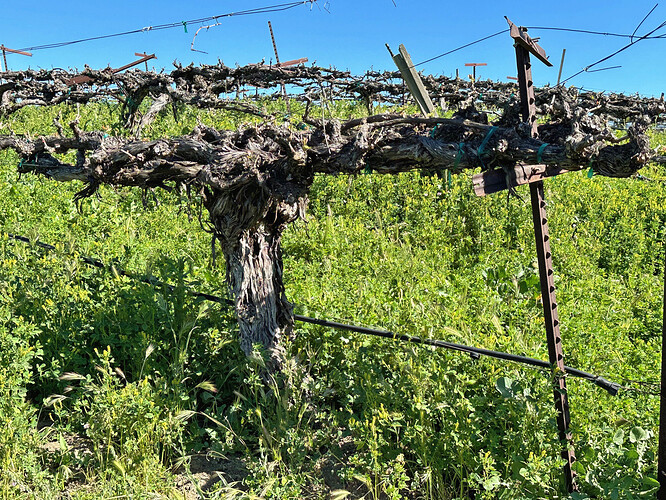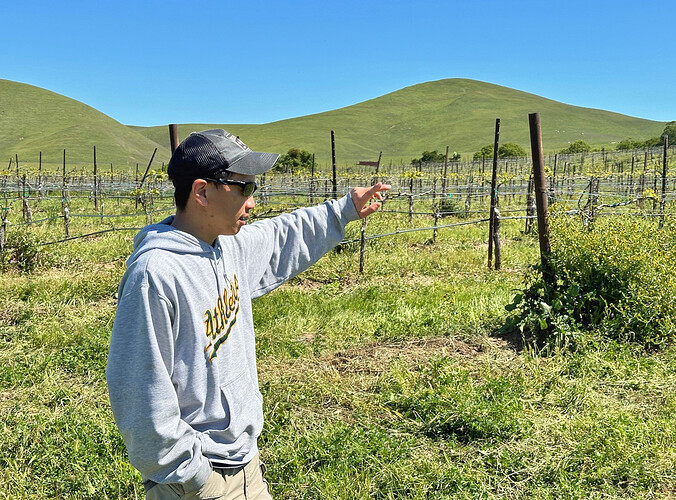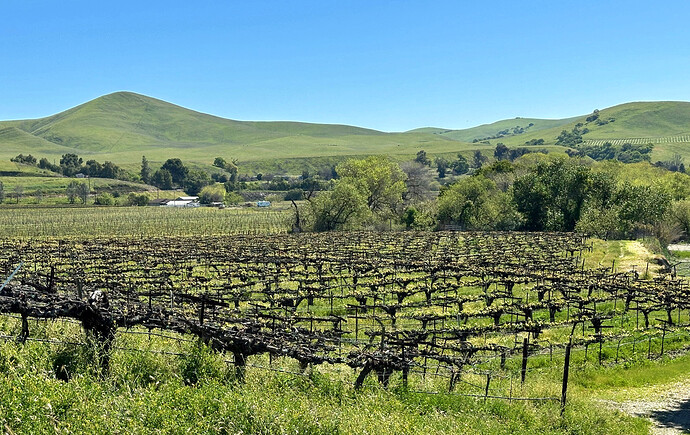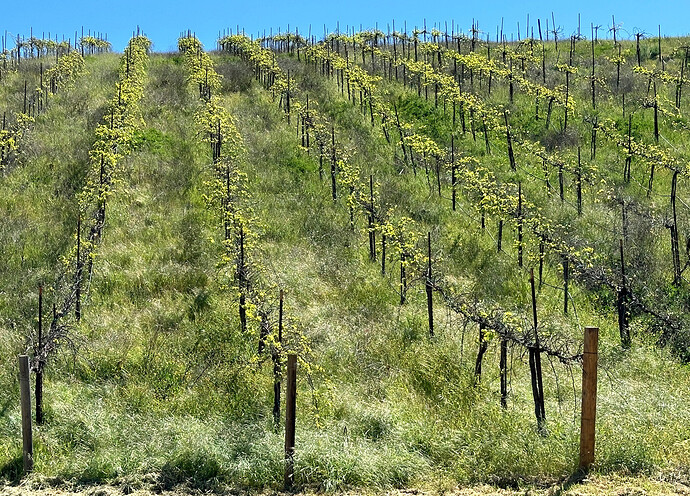San Benito County Vineyards and Wine – Part 1
I’ve posted a portion of a report on May wine visits with friends Wes and Stephanie to Siletto Family Vineyards plus Blade & Talon Wines and to Stirm Wine Company. This portion covers the visit to Siletto – a post covering Blade & Talon and Stirm will be following soon. The full version of this part of the report is on the Grape-Nutz.com website:
(San Benito Vineyards and Wine - April 2024)]San Benito County Vineyards and Wine, May 2024
Introduction to San Benito County
The vineyards of San Benito County include some of the older plantings in California, yet they’re not very well-known, even among many fans of California wine. The region is located south of Santa Clara Valley and east of Monterey County, between the Gabilan and Diablo mountain ranges. It’s generally quite warm during the summer, though afternoon maritime breezes coming down from Monterey Bay and through the Hollister area help to temper the heat. Historically, agriculture and mining (mainly for quicksilver) have been important to the county’s economy, though mining operations have fallen off over the years. The region includes two major earthquake faults – the San Andreas and Calaveras faults run through the county, contributing to its interesting geology and mix of rock and soil types, including volcanics, decomposed granite, and limestone, as well as some rare minerals.
The first commercial winegrape plantings in San Benito County came around 1851, when Frenchman Theophile Vaché planted vines in Cienega Valley, at what are now Eden Rift (formerly Pietra Santa) and DeRose vineyards. William Palmtag purchased Vaché’s vineyard in 1883 and expanded it, adding more grape varieties. It’s been said that some vines planted in the mid-1850s remain at DeRose. Enz Vineyard, in the same area, may have first been planted as early as the 1880s, and some of those vines are still producing. Other vineyards that were initially planted by the early 1900s include Wirz and Gimelli (formerly El Gabilan). Wirz also has Riesling vines dating to the 1960s. Josh Jensen began planting his Calera vineyards in the Mount Harlan area in 1974. San Benito County’s vineyard heyday came in the 1970s when wine giant Almaden had extensive vineyards in the area. But that era didn’t last long for the region, and many of those vineyards are gone now. Newer plantings of note in the past 30-40 years include Siletto Family Vineyards, Vista Verde, and Paicines Ranch.
San Benito County includes five AVAs entirely within the county borders: Cienega Valley (1982), Lime Kiln Valley 1982), Paicines (1982), San Benito (1987), and Mount Harlan (1990). There are also three AVAs that are partially within San Benito County, including their most recent one, Gabilan Mountains (2022).
In the past ten years or so, a number of smaller-scale vintners have discovered the vineyards of San Benito County and have sought out fruit from there, particularly older plantings of varieties such as Négrette and Cabernet Pfeffer, which may not be grown anywhere else in California. And the newer vineyards in particular have planted or grafted many varieties originally from Italy, Spain, Greece, France, and elsewhere in Europe that are little-known in California vineyards. Nearly all of these vintners make their wines outside of San Benito County, and there are still very few wineries within the county itself.
Siletto Family Vineyards
Our first San Benito County stop of the day was at Siletto Family Vineyards in Tres Pinos. I was introduced to the Siletto vineyards through Bryan Harrington of Harrington Wines in San Francisco, where I worked part-time for many years until Bryan decided to close down his winery after the 2018 vintage. Bryan initially was looking for Négrette grapes – there’s very little of this old California heritage variety (where it was once called Pinot St. George) that originated in southwestern France still planted in the state, where it’s almost exclusively found in San Benito County. Bryan learned that there was Négrette available from grower Ron Siletto and bought some in 2012, and he became one of the first to vineyard-designate Siletto on wine labels. In succeeding years, he increased his yearly purchases from Ron to 4-5 varieties and ultimately to over a dozen varieties in 2018. Bryan also encouraged Ron to graft many Italian grape varieties – a number of which are still rarely-seen in California – at his vineyard sites and Ron was enthusiastic about doing that, wanting his vineyards to better reflect his Italian heritage. During the years that the two worked together they also became friends, and even though Bryan was no longer making wine in 2020 he was heartbroken when Ron passed away in July of that year.
Ron’s parents came to the US from the Piemonte region of Italy, and he was born in Boston in 1933 – Italian was his first language as a child. After graduating from Boston College and serving five years in the Navy, he worked in the advertising business. From there he went to work for Almaden Vineyards, then one of the largest wine companies in California, and ultimately became the company president. Among Almaden’s properties were extensive vineyards and a couple of winery facilities in San Benito County, and Ron became familiar with the region. When Almaden was sold to Heublein in 1986, Ron purchased one of their small ranch properties in San Benito County and launched a further chapter in his career, farming vineyards. Over the following years, he expanded his vineyard operations from that initial 20-acre planting to six sites with over 170 acres and about 40 grape varieties. Ron loved working with the more esoteric varieties that have found a special home in San Benito County, such as Négrette and Cabernet Pfeffer, and he was able to plant some of these at his vineyards.
Since Ron’s passing, his son John has headed Siletto Family Vineyards. John sometimes worked with his father but his main career was at Driscoll’s – well-known for their strawberries as well as other berries – where for 25 years he gained knowledge in farming and eventually ran their nurseries. Siletto Family Vineyards has now consolidated to three vineyard sites with around 90 planted acres. They’ve also completed their transition to organic farming and are now certified by the California Certified Organic Farmers (CCOF) organization. John – along with Nat Wong, who now manages the vineyards – is working to improve soil health and position the vineyards so they will continue to produce high-quality fruit for years to come.
I was able to get in touch with Nat, who took the position of Siletto Family Vineyards general manager in early 2023, to arrange our visit there. Wes, Stephanie, and I met him outside of the house where he lives on the Wheeler Vineyard property, one of three current Siletto vineyard sites. The house is on a small hill, affording a good overview of the area and all three of the vineyards. Wheeler Vineyard, which the Siletto family owns, and Calleri Vineyard, which they lease, are adjacent to one another on the west side of Highway 25 and just east of Tres Pinos Creek. Siletto Vineyard is a little farther east, across the highway. Each of the three vineyard sites has about 27-30 acres planted, and the Siletto property also includes around 60 acres in addition to the vineyards.
After Nat gave us a quick overview of the area from in front of the house, we all got into his truck for a tour of the vineyards, starting with Wheeler. First planted with Cabernet Sauvignon vines in 1974, Wheeler Vineyard is now on the registry of the Historic Vineyard Society. Wente clone Chardonnay was planted 1977 and Brunello clone Sangiovese in 2007. The Cabernet and Chardonnay vines are all on old AXR1 rootstock at Wheeler – this was once recommended in California as a phylloxera-resistant rootstock but that has proven not to be the case. Nat said that the combination of sandy loam soil and the isolated vineyard location has kept the vines free of phylloxera.
Other than the 10-acre Cabernet Sauvignon block and 17.5-acre Chardonnay block at Wheeler, none of the blocks at any of the three Siletto Family Vineyard sites are more than four acres in size, and many of them are less than one acre. We stopped near the top of the gently-sloping site to take a closer look at the gnarly 50-year old Cabernet Sauvignon vines. Nat told us that they will be grafting Frappato onto some of the Chardonnay at Wheeler Vineyard, as well as Schiava and Mencía.
Getting back into the truck, we continued to the adjacent Calleri Vineyard. Nat said that much of this site was originally planted to Merlot in 1994, but the vines have been grafted to many other varieties in recent years, including Falanghina, Sagrantino, Greco di Tufo, Aligoté, Négrette, Mourvèdre, and Cabernet Franc. We stopped to look at some of the original Négrette vines at Calleri, which were also planted in 1994.
As mentioned earlier, Ron Siletto was excited about grafting lesser-known Italian varieties in his vineyards, and these newer varieties – as well as some of the older ones such as Cabernet Pfeffer and Négrette – have attracted a lot of new customers for the vineyards’ fruit. Nat and Ron’s son John are planning to continue on this path of grafting interesting varieties at the three sites. Fiano, Grillo, and Nero d’Avola are some of the varieties that Nat told us they will probably graft in the coming years. He said that they’re still experimenting with the right locations for many of these new grafted vines, and that they may shift some from one vineyard or block to a different one over the next few years.
As we looked at the rows of older Négrette vines at Calleri Vineyard, Nat told us that he’s working on a mix for cover crops. What’s there now is native vegetation, and Nat plans to retain some of that but supplement it with new cover crops that will attract pollinators as well as host beneficial predator insects. He showed us bee hives that a local organization has placed adjacent to the vineyard. He also said that predator bird boxes will be added at various locations at the three vineyard sites, to help control gophers and other vineyard pests. He noted that wild pigs have sometimes been a problem, as they are increasingly in a number of California vineyards, and that they are particularly prevalent in San Benito County. Nat told us that they plan to add some hedgerows that they hope will both deter the pigs as well as provide additional beneficial insect habitat.
Nat took us from Calleri Vineyard out to Highway 25, where we headed south for just a very short distance, and then to Siletto Vineyard. Unlike the gently-sloping Wheeler and Calleri sites, Siletto is on a hillside – some portions are quite steeply sloped while other parts are alluvial terraces. The soil here is rockier gravelly loam plus some calcite, a type of limestone found in San Benito County. As with Calleri, over a dozen grape varieties are currently grown at Siletto, a number of them grafted in the past five years. We stopped briefly to look at a planting of Grenache that Nat told us would be largely grafted to other varieties soon, including more Sagrantino and Montepulciano, as well as Freisa, which the family had grown at one of the sites they no longer farm. Varieties higher up on the hillside include Mencía – this is now the only Spanish variety at any of the three vineyard sites but Nat said that they may look to graft other ones in the future. The oldest ungrafted vines at the Siletto site are own-rooted Cabernet Pfeffer that date from 1992.
We stopped on our way back down the hill at a spot where we could get a good look back toward the Wheeler and Calleri vineyards across the highway. We could also see the gap in the hills to the west where mid-afternoon maritime winds blow in to help moderate the warm summer temperatures in the area. Nat noted that the area where the Siletto vineyard sites are located includes two notable waterways (Tres Pinos Creek and San Benito River), two mountain ranges (Gabilan and Diablo), plus the San Andreas and Calaveras faults. This complexity of geological features helps give the region a wide range of rock and soil types as well as a diversity of native plants and animals.
We talked with Nat about the explosion of new customers for the Siletto Family Vineyards fruit over the past few years. For many years, Ron Siletto sold his fruit mainly to larger companies such as Mondavi, Gallo, and Constellation that used it in blends. But even early on he also sold to a small number of vintners who were interested in the more esoteric varieties that he grew, such as the Négrette and Cabernet Pfeffer. Ken Volk was the best-known of these vintners, first when he was the winemaker at Wild Horse Winery in the Paso Robles area and later when he launched his own label. Siletto Family Vineyards now sells fruit to about 50 customers, none of them very large and many of them quite small and not well-known. Most don’t buy a lot of fruit, but that sort of flexibility to sell to smaller-production vintners is a big part of what has drawn them to Siletto. Nat manages the vineyards and maintains a small year-round crew – the main vineyard hand Manuel Mora has been there for over 30 years. Nat said that he actually prefers to work with selling smaller lots of fruit so their own crew can handle picking the fruit themselves, helping to keep costs down.
Nat told us how he keeps in touch with each customer as the growing season progresses, and takes fruit samples often so he can transmit information to the customers. To better do this, he now has a Foss machine that can quickly produce a detailed panel of data of the fruit samples. Before he came to Siletto, Nat had been a winery enologist, so this background is a great help in his ability to deal with this aspect of his work at the vineyards. When I looked over the list of winery customers on the Siletto website, I was stunned both at how many I know and how many I didn’t realize purchase fruit from Siletto. Word has clearly spread that the Siletto family is willing to sell quality fruit to small and barely-established vintners when many other vineyard owners and managers won’t even talk to anyone who may only want to buy a ton or two.
This was a fun visit with Nat to the Siletto Family Vineyards, and we had a terrific time with him as he gave us a tour of all three vineyard sites. Though they’re not as old as some of the vineyards in nearby Cienega Valley, the Siletto vineyards include a more diverse selection of different grape varieties than any other vineyard in the region, and many of these varieties are quite rare in California. It was great to hear that Nat and the Siletto family are planning to continue adding even more of these really interesting varieties in the future. And it was also encouraging to hear of their dedication to continue improving their organic farming methods to help keep the soil and the vines as healthy as possible for years to come. With so many smaller-production wineries now purchasing fruit from Siletto for their wines, I think we can expect to see even more vineyard-designated wines from there in the coming years – something to look for at your local and online wine shops.
Siletto Family Vineyards is just one of the San Benito County vineyards – both old and new – that have become fruit sources for many up-and-coming winemakers as well as for some more established labels. With vintners such as Nat Wong of Blade & Talon, Ryan Stirm of Stirm, Los Chuchaquis, and Companion, and others using San Benito fruit in many of their wines, it’s becoming easy to associate the region with some of California’s most exciting new wines.
